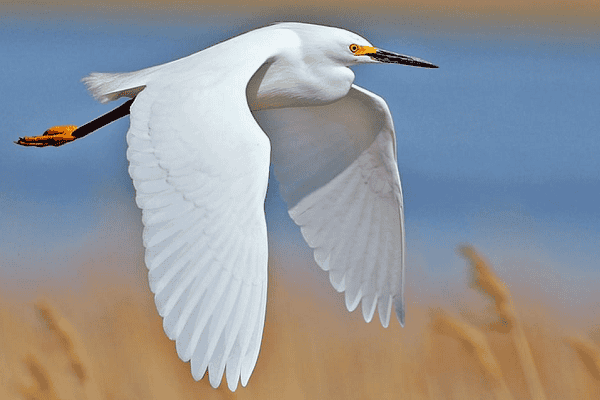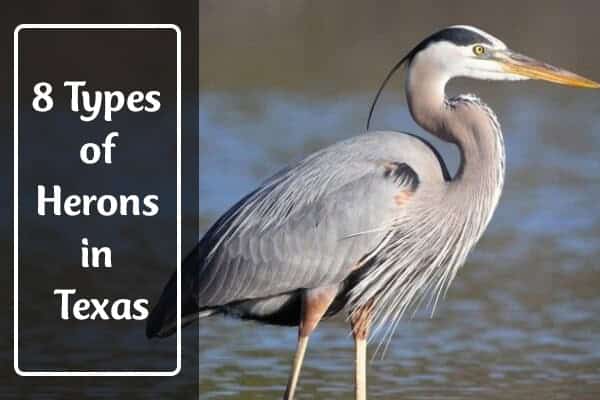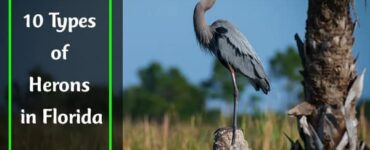Herons in Texas: Imagine elegant birds soaring over Texas skies and wading along its shores. These beautiful creatures play a vital role in nature. Not only are they beautiful, but they also help keep fish and bugs in check. Let’s explore their world, find out where to see them, and learn how we can protect their future. Whether you’re a birdwatcher or just curious about nature, this journey into the lives of Texas Herons will be eye-opening!
Here we’ll learn about 8 different types of Herons in Texas
1. Great Blue Heron
- Scientific name: Ardea herodias
- Life span: 15 years
- Size: 91-137 cm
- Weight: 2-3.6 kg
- Wingspan: 167-201 cm
- Status: Least Concern
The Great Blue Heron is a big, beautiful bird you can find all over North America, including Texas. It has blue-gray feathers, a black stripe over its eye, and a long bill. These birds like to stand in shallow water near wetlands and coasts.

In Texas, they usually stay with the same partner and come back to the same place every year to build their big nests out of sticks in trees by the water.
Their nesting starts in late winter. The males show off and bring sticks to make nests to attract females. The females lay 2-6 eggs, and both parents help keep them warm for about a month. After the baby herons hatch, they grow fast and leave the nest in two months.
These herons eat a lot of fish, but they also eat insects, frogs, snakes, and small animals. They’re good at waiting for the right moment to catch their food or walking in shallow water to hunt.
Since the 1970s, Texas has protected the Great Blue Heron. People are working to keep their homes safe and their numbers up.
2. American Bittern
- Scientific name: Botaurus lentiginosus
- Life span: 6 years
- Size: 58-81 cm
- Weight: 0.4-1 kg
- Wingspan: 91-104 cm
- Status: Least Concern
The American Bittern is a bird that’s really good at hiding. It lives all over North America, even in places like Texas where there are lots of wetlands and marshes.

Firstly, this bird has brown stripes that help it hide in the grass and bushes. If it feels scared, it stands really still and points its beak up to the sky, which makes it look just like a stick or a reed.
Even though it’s hard to see, you can hear the American Bittern because it makes a loud sound that sounds like gulping, and you can hear it from really far away.
Next, let’s talk about where they live in Texas. They build their homes on the ground in marshy areas, hidden by tall grass. When it’s time to have babies, in the early spring, the male birds show off with fancy moves to get the female birds’ attention.
The mom bird lays between 3 to 5 eggs, and both parents take turns keeping the eggs warm for about a month. Once the baby birds hatch, both parents feed them until they’re ready to fly, which takes about six weeks.
3. Black-Crowned Night-Heron
- Scientific name: Nycticorax nycticorax
- Life span: 20 years
- Size: 61-69 cm
- Weight: 0.6-1.2 kg
- Wingspan: 91-122 cm
- Status: Least Concern
The Black-crowned Night-Heron is a cool bird that you can find in many places like the Americas, Europe, and Asia. It’s easy to spot because it has a black top on its head and back, gray wings, and bright red eyes.

First off, these birds have a special beak that’s long and strong, perfect for catching fish, bugs, and other small animals. They are the most common type of heron all over the world, except in the cold place called Antarctica.
Herons in Texas, the Black-crowned night heron is really good at hunting. It eats a lot of different things, like fish, frogs, and little water animals called crustaceans. They’re super patient and can stay still for a really long time until the perfect moment to grab their food.
When they see something they want to eat, they use their sharp beak to catch it fast and eat it all at once. You can often see these smart birds sitting by the water, waiting for the right time to catch something.
4. Green Heron
- Scientific name: Butorides virescens
- Life span: 7 years
- Size: 38-50 cm
- Weight: 0.1-0.2 kg
- Wingspan: 58-66 cm
- Status: Least Concern
The Green Heron is a small bird that lives in North America, including Texas. Even though it’s tiny, it stands out with its greenish-black feathers, chestnut neck, and bright yellow legs.

Here’s something cool: Green Herons are one of the few birds that use tools. Imagine them dropping little things into the water to get fish’s attention! They even make fishing lures out of twigs and feathers.
When they’re not busy being crafty, they build their nests in trees near water. They lay about 3 to 5 eggs, and both parents take turns keeping the eggs warm. Once the chicks hatch, they’re all naked and helpless, but they grow fluffy feathers quickly.
Mom and Dad feed the chicks by regurgitating food (yes, it’s a bit gross, but it works!). By the time the chicks are about four weeks old, they’re ready to fly.
Now, what’s on the menu for these herons? Well, they’re not picky eaters. They gobble up fish, frogs, snakes, bugs, and even small mammals. But what really sets them apart is their talent for using tools. They drop bait (like bread or insects) into the water to attract fish, then snap them up with their sharp beaks. Smart, right?
5. Great Egret
- Scientific name: Ardea alba
- Life span: 15 years
- Size: 81-101 cm
- Weight: 0.7-1.4 kg
- Wingspan: 140-170 cm
- Status: Least Concern
The Great Egret is a beautiful white bird that you can see all over Texas, and it’s also common in Denmark now. It’s pretty big, with a wingspan of five feet, long legs, and a yellow beak.

Here’s a cool thing: the Great Egret’s fluffy feathers used to be used for clothes and hats a long time ago, which almost made them disappear. But people worked hard to protect them, and now there are lots of them again.
In Texas, these birds make their homes in trees near water. They use sticks to build their nests and lay 3 to 4 eggs. Both the mom and dad egret take care of the eggs for about a month. When the baby egrets hatch, they have soft white feathers and get fed by their parents until they’re six weeks old and can fly.
The Great Egret is also a really good hunter. It eats fish, frogs, and even small animals. You can see them standing in shallow water, waiting to catch something with their quick beak.
They’re very pretty to watch as they move smoothly through the water. It’s sad to think that they were almost gone because people wanted their feathers for fashion, but now they’re safe and sound.
6. Cattle Egret
- Scientific name: Bubulcus ibis
- Life span: 9 years
- Size: 46-56 cm
- Weight: 0.2-0.5 kg
- Wingspan: 88-96 cm
- Status: Least Concern
The Cattle Egret is a small bird with a cool story. It originally came from Africa, but now you can find it all over the world, including in Texas where there are grasslands and wetlands.

Here’s what makes it stand out: it’s all white with a yellow-orange beak. When it’s looking for food, you’ll often see it hanging out with cows, horses, and other big animals in fields.
But the best part? Back in the 1930s, these birds started following herds of cattle. Why? Because the cattle stirred up insects and other tiny animals while grazing. So, the Cattle Egrets got a free meal!
In Texas, they build their nests in trees or shrubs using sticks. They lay about 3 to 5 eggs, and both mom and dad take turns keeping the eggs warm. When the chicks hatch, they’re covered in soft white fluff. Their parents feed them until they’re about four weeks old and ready to fly.
These egrets are super friendly and like to hang out in big groups. Sometimes, there are thousands of them together! They’re always busy looking for food, like insects, rodents, and little amphibians.
Check Our Previous Articles:
7. Snowy Egret
- Scientific name: Egretta thula
- Life span: 17 years
- Size: 56-66 cm
- Weight: 0.3-0.6 kg
- Wingspan: 86-102 cm
- Status: Least Concern
The Snowy Egret is a beautiful white bird that you can see in many places across North and South America, including Texas. It likes to hang out in marshes, swamps, and near the coast where the water is shallow.

Here’s what makes it special: it has long, wispy feathers that used to be super valuable for making fancy clothes. Back in the late 1800s, people hunted these birds a lot because of their feathers.
But guess what? People worked hard to protect them, and now there are plenty of Snowy Egrets around. They build their nests in trees near water, using sticks. When it’s time to have babies, they lay about 2 to 5 eggs. Both the mom and dad take turns keeping the eggs warm.
When the chicks hatch, they’re covered in soft fluff. Their parents feed them by regurgitating food (yes, it’s a bit weird, but it works!). By the time the chicks are about six weeks old, they’re ready to fly.
Now, let’s talk about their menu. Snowy Egrets are hungry birds! They eat all sorts of things like fish, crustaceans (those are like tiny water animals with shells), and insects. And get this—they have a cool trick. They stomp their feet in the water to scare out their prey. Clever, right?
8. Least Bittern
- Scientific name: Ixobrychus exilis
- Life span: 6 years
- Size: 28-36 cm
- Weight: 0.1-0.2 kg
- Wingspan: 41-51 cm
- Status: Least Concern
The Least Bittern is a tiny heron that lives in marshes in North America, including Texas. It’s easy to recognize because of its chestnut, black, and white stripes.

Even though it’s small, it has big feet that help it walk on plants that float on water. One cool thing about this bird is its loud call, which sounds like “coo-coo-coo” or chuckling.
They’re shy and like to hide, so you have to be patient to see them. They sneak around the edges of wetlands, looking for food with their long bills.
Herons In Texas, the Least Bittern is super secretive about where it lives. It builds its nest in thick plants near water, using sticks to make a strong base. They lay 3 to 6 eggs, and both parents keep them warm for about three weeks. When the chicks hatch, they’re fluffy and get fed by their parents until they can fly at about five weeks old.
The Least Bittern is a great hunter. It eats fish, frogs, bugs, and small animals. Sometimes, when there’s not much food, it eats plants. It’s really good at catching food with its sharp beak.
Frequently Asked Questions about Herons in Texas
Q1. What kind of herons live in Texas?
Several species inhabit Texas, including the Great Blue Heron, Green Heron, and Yellow-crowned Night Heron.
Q2. Are herons protected in Texas?
Yes, herons are protected under state and federal laws, including the Migratory Bird Treaty Act.
Q3. Do great egrets live in Texas?
Yes, great egrets can be found in Texas, particularly in wetland habitats along the coast and inland.
Q4. What is the difference between a heron and a crane?
While both are long-legged wading birds, herons typically have a straighter neck in flight and fold their necks in an “S” shape when resting, while cranes have a more elongated neck and tend to fly with their necks extended. Additionally, cranes often have a more varied diet, including grains and seeds, whereas herons primarily feed on fish and aquatic prey.





Add comment